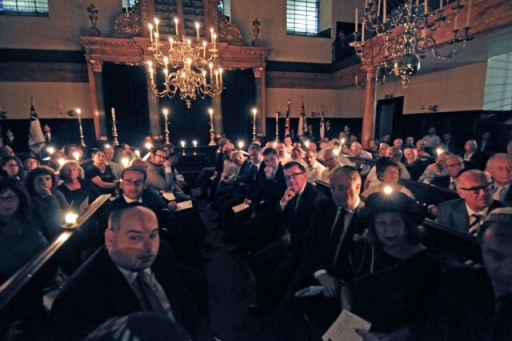Dr Jillian Davidson has filed this personal account of how a Synagogue in London marked the Lights Out commemeration event on August 4th 2014.
The Department for Culture, Media and Sport and 14-18-NOW invited the Bevis Marks Synagogue and the Board of Deputies of British Jews, on behalf of the British Jewish Community, to participate in “Lights Out.” Dedicated in 1701 and situated in the City of London, Bevis Marks is the oldest synagogue in the UK. Its seven hanging brass candelabra, which represent the seven days of the week, made Bevis Marks a most fitting synagogue to host a candlelit service.
With the help of the Jewish Military Museum, the Association of Jewish Ex-Servicemen and the Jewish Lads’ and Girls’ Brigade, the Bevis Marks Synagogue and the Board of Deputies presented a moving and memorable service of addresses, prayers and psalms, readings of soldiers’ letters and Isaac Rosenberg’s poems and a minute of silence.
Bevis Marks was also an appropriate synagogue since, on the wall to the left of its entrance, there stands a memorial plaque to the thirty-nine members of the Spanish and Portuguese Jewish Congregation, who gave their lives for their country in the 1914-1918 War. One of the names inscribed belonged to Lieutenant Frank de Pass (died in France, November 25th 1914, aged 27), the first Jew ever to receive the Victoria Cross and the first of five Jewish recipients in World War One. Another belonged to Captain Robert Sebag-Montefiore, the grandson of one of the former presidents of the Spanish and Portuguese Community and of the Board of Deputies, Sir Joseph Sebag-Montefiore. Robert Sebag-Montefiore died of wounds, sustained in action in Gallipoli, in November 1915, aged thirty-three.
“It is only right and proper,” Chief Executive of the Board of Deputies, Gillian Merron declared, that “from all across the Jewish community, we congregate under one roof to unite for the commemoration of the beginning of the First World War.” Ms. Merron emphasized that they were not only commemorating the 50, 000 Commonwealth Jews who fought for Great Britain. They were also remembering the Jews who fought for Germany, Austria, France, Italy, and Russia. In addition, of course, the Jewish community was remembering its non-Jewish brothers and sisters, who served and lost their lives in the War.
The Lights Out campaign blended well with Jewish custom and tradition. For Jews, the lighting of candles is highly symbolic. Ms. Merron explained that Jews light candles not only on a yahrzeit, the anniversary of a lost relative, but also to welcome in the Sabbath, festivals and Hanukkah, the holiday of lights.
By ironic coincidence, the centenary of England’s entrance into World War One, on August 4th, happened to fall this year on the 9th of Av in the Jewish calendar. The 9th of Av, called in Hebrew Tisha b’Av, is the most mournful day in the Jewish year. It is a day of fasting and for the recitation of the Biblical book of Lamentations, as Jews mourn the destruction of the First and Second Temple in Jerusalem, the beginning of their Exile and several other calamities.
Immediately prior to the Lights Out service between 10 and 11 o’clock, there was indeed a Tisha b’Av service at the Bevis Marks Synagogue, during which Lamentations was chanted. In accordance with the verse in Lamentations “He has settled me in darkness,” the electric lights in the synagogue were turned off, also for this service.
By even greater ironic coincidence, the outbreak of war on August 1st 1914, between Russia and Germany on the Eastern Front, where the majority of Jews then lived, also fell on Tisha b’Av. Rabbi Joseph Dweck, the Senior Rabbi of the Spanish and Portuguese Jews’ Congregations, in his keynote address, reflected upon the further irony that both catastrophes began with assassinations; in the case of the destruction of the Temple, it was, however, a character assassination.
The Rabbis told a story in the Babylonian Talmud of Kamsa and Bar Kamsa. A wealthy man throwing a party bid his servant to invite his friend Kamsa. By accident, the servant invited Bar Kamsa, similar in name to the friend but actually an enemy of the wealthy man. Upon turning up and being publicly rejected by his host, Bar Kamsa swore his revenge and turned to the Romans. The Rabbis saw in this story an illustration of how internal tensions among people exacerbated the external threat from conquerors – a lesson equally applicable to World War One (and today).
Rabbi Dweck spoke of the golden lessons of World War One. The extreme measures inflicted upon Germany by the treaty of Versailles provoked precisely the kind of hatred it was meant to prevent. In this way, World War One helped to cause the even greater tragedy of World War Two.
As we watch extremism around the world, Rabbi Dweck implored, we must not forget the effects of World War One. “As we face our loss [Tisha b’Av and WWI], we always have two choices: we can recover, literally re-cover, cover up what has happened or we can look into the grim eye of tragedy and learn from it.”
